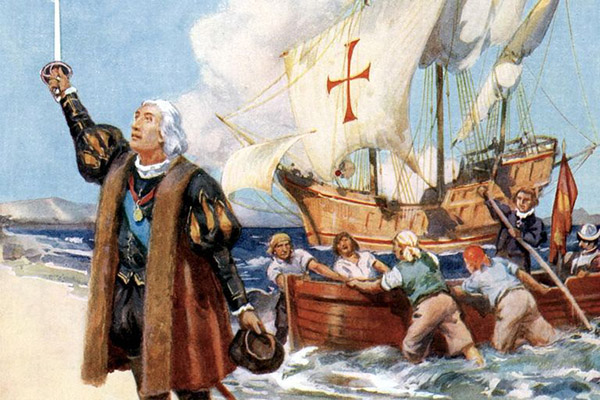Latin America is a term used to describe the countries and republics of the Western Hemisphere where Spanish, Portuguese or French are recognized as the official languages. The following briefly highlight a few of the events which molded it.
Christopher Columbus’ Arrival in the Americas: October 12, 1492
The lands of North, Central and South America had been inhabited by great civilizations well before Christopher Columbus set foot on San Salvador in the 15th century. Columbus’ voyages are viewed with great significance perhaps due to how they helped change the course, destiny and landscape of the peoples of the Americas.
Columbus and the subsequent flood of treasure-seeking Spaniards endeavored to civilize and Christianize the natives. In so doing, the Americas saw a forced marriage of sorts between the old Native American civilization and the new European culture. This union is still evident today within the people of the Latin America as well as within their customs.
Bartolomé de las Casas writes Devastation of the Indies: 1542
Viewed by many historians and scholars as a founder of human rights, the Dominican priest and writer was instrumental in Spain’s passage of the “New Laws”. The New Laws repealed the previously established laws which allowed the Spanish exploitation of natives essentially enslaving them in what was called the encomienda system.
An eye witness to the atrocities thrust upon the natives of the newly discovered continent, Las Casas advocated for the rights of the native people of the Americas as well as for the end of the forced labor.
50 years of abuses against natives had already transpired before the passage of the New Laws which were met with great outrage by Spanish colonist. Though the repeal of the old laws didn’t abolish the abysmal treatment of Native Americans, had it not been for the efforts of men like Las Casas, the devastation may very well have been much more severe.
Miguel Hidalgo’s Grito de Dolores: September 16, 1810
Before 1810, Mexico was known as Nueva España (New Spain) and was the chief Spanish colony in the world. With Napoleon’s invasion of Spain in 1808, many in the colonies united under the Spanish monarchy. In Mexico in 1809, los insurgents (the insurgents), took this opportunity to gather, prepare and organize themselves to shake free of Spanish rule.
Miguel Hidalgo y Costilla – considered the Father of Mexican independence – was a priest of Spanish descent who together with fellow insurgents, planned to make their proclamation of independence towards the close of the year 1810. The conspirator’s plans were somehow leaked forcing the rebels into action.
Upon learning that the conspiracy had been uncovered by Spanish authorities, Hidalgo went to his church in the town of Dolores, Guanajuato the late evening of the September 15th. Ringing the church bells as a call to his parishioners, Hidalgo gave an impassioned speech in the early morning hours of the 16th of September 1810 beginning the rebellion and setting in motion the Mexican War of Independence and Mexico’s eventual independence from Spanish colonial rule.
The War of the Triple Alliance: May 1, 1865
Also referred to as the Paraguayan War or the Great War, The War of the Triple Alliance began as a disagreement over navigation rights of Rio de la Plata and went on to be the bloodiest war South America has seen.
The combatants of the war were Paraguay on one side of the conflict and Argentina, Brazil and Uruguay on the other. The clash had been brewing for years due quarreling between Paraguay and their much larger, more powerful neighbors of Argentina and Brazil over boundary issues and tariff disputes.
In the Uruguayan election of 1864, Brazil was instrumental in the victory of the Colorado Party candidate over the Blanco Party opponent. Paraguayan leader, Francisco Solano Lopez viewed this interference on the part of Brazil as a threat to the regional balance of power and declared war on its neighbor. Argentina and the Colorado Party controlled Uruguay allied with Brazil and the Triple Alliance declared was against Paraguay on May 1, 1865.
The war lasted for five bloody years, ending with the death of Solano Lopez. Paraguay was left devastated, the war having decimated its population from over half a million to roughly 220,000 by war’s end. Of the Paraguayan surviving population, only 13% were adult males.
The Cuban Revolution: July 26, 1953
The attack on the Moncada barracks on July 26, 1953 may not have played out exactly the way 27 year old Fidel Castro and his rebels might have liked, but the events set in motion that day were essential to the ultimate ousting of the US-backed Cuban dictator Fulgencio Batista y Zaldívar.
The rebellion in Cuba which began with a little over 100 men, grew and flourished thanks in part to the efforts of the 26th of July Movement which promulgated the tenets behind the rebellion which included economic equality, industrialization, unemployment, land ownership and civil liberties, among other key beliefs for the necessity of revolution.
Regardless of how Castro’s leading of Cuba’s revolt and his subsequent ruling of the country are viewed, this stands as proof of the impact a few idealistic young lawyers along with the hunger of an oppressed people can have on the world.
Sources:
- Bockman, Larry James. “Spirit of Moncada: Fidel Castro’s Rise To Power,1953-1959”. Marine Corps Command and Staff College. April 1984. Retrieved 2009-07-25
- Castro, Fidel. “What Cuba’s Rebels Want.” Nation. 11/30/1957, Vol. 185 Issue 18, p399-401
- Muldoon, James. “Christopher Columbus”. Berkshire Encyclopedia of World History. 2005. Vol. 2 p390
- “Paraguay”. CIA World Fact Book Online.
- Tuck, Jim. “Miguel Hidalgo: The Father who Fathered a Country (1753-1811)”. Mexconnect. Oct. 9 2008
- “War of Triple Alliance”. Funk & Wagnalls New World Encyclopedia. 2002








